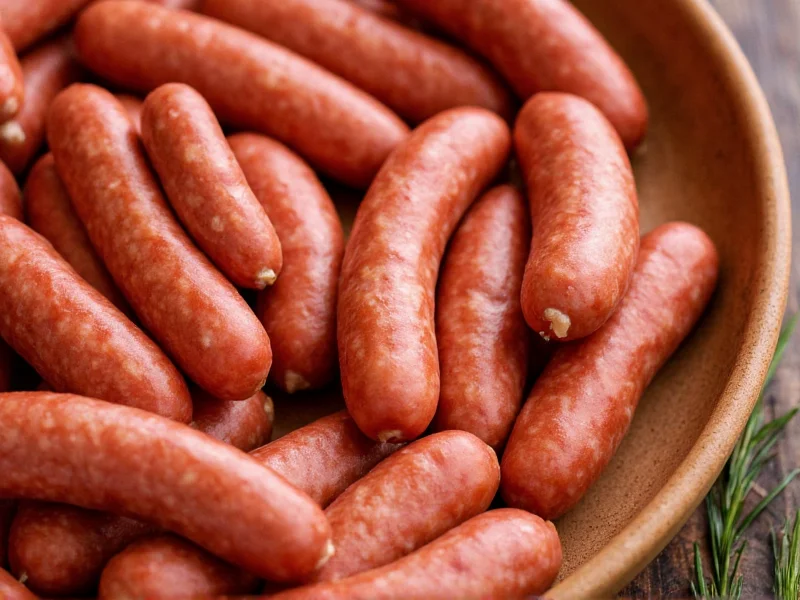Sausage has been a staple food for centuries, with recipes varying across cultures but sharing fundamental components. Understanding what is made of sausage reveals both traditional craftsmanship and modern food science. At its core, sausage transforms less desirable meat cuts into flavorful, preserved products through careful ingredient balancing.
Primary Ingredients in Sausage Production
The foundation of any sausage consists of four essential elements. Meat provides protein structure, fat delivers moisture and richness, salt acts as both preservative and flavor enhancer, and seasonings create distinctive regional profiles. When examining what ingredients are in sausage, it's important to recognize that quality varies significantly between artisanal and mass-produced varieties.
| Ingredient Category | Typical Percentage | Common Examples |
|---|---|---|
| Meat | 60-80% | Pork shoulder, beef chuck, chicken thighs |
| Fat | 15-30% | Pork backfat, beef suet, poultry skin |
| Salt | 2-3% | Non-iodized table salt, kosher salt |
| Seasonings | 1-5% | Pepper, garlic, paprika, herbs |
Meat Selection and Processing
Understanding what kind of meat is used in sausages reveals regional preferences and quality indicators. Pork remains the most common base globally, particularly shoulder cuts which provide ideal meat-to-fat ratios. Beef features prominently in German bratwurst and South African boerewors, while poultry sausages have gained popularity for lower fat content.
Butchers typically use a 70:30 meat-to-fat ratio for balanced texture. The meat undergoes coarse grinding (5-8mm plates) for fresh sausages or fine emulsification (3mm plates) for products like hot dogs. Temperature control during grinding (below 4°C/40°F) prevents fat smearing, which would compromise texture.
Essential Seasonings and Additives
Common sausage seasonings and spices transform basic meat mixtures into distinctive products. While salt remains non-negotiable, other flavorings vary dramatically:
- European styles: Black pepper, nutmeg, mace, and marjoram feature in German varieties
- Mediterranean styles: Fennel seed, garlic, and red pepper flakes define Italian sausages
- Asian adaptations: Five-spice powder, ginger, and soy sauce create unique fusion profiles
Modern production often includes sodium nitrite (0.01-0.02%) to prevent botulism and maintain pink color. While controversial, this preservative has dramatically reduced foodborne illness from cured meats. Natural alternatives like celery powder (which contains nitrate) serve similar functions in "uncured" products.
Sausage Casings: Natural vs. Synthetic
The casing represents what gives sausage its characteristic shape and texture. Three primary types exist:
- Natural casings: Made from sheep, hog, or beef intestines; provide traditional texture and allow smoke penetration
- Collagen casings: Derived from animal hides; consistent diameter but less authentic texture
- Synthetic casings: Cellulose or plastic; used for skinless products like hot dogs
Artisan producers prefer natural casings for their ability to breathe during fermentation and smoking. The casing's permeability affects moisture loss during cooking, directly influencing final product juiciness.
Regional Variations in Sausage Composition
Examining traditional sausage meat composition across cultures reveals fascinating adaptations. Spanish chorizo incorporates smoked paprika and garlic, while French saucisson sec uses wine and pepper. Thai sai ua features lemongrass and kaffir lime leaves, demonstrating how local ingredients shape regional specialties.
British bangers traditionally contained higher breadcrumb content (up to 30%) as meat extenders during wartime shortages. Polish kielbasa emphasizes garlic and marjoram, with some varieties including crushed juniper berries. These variations highlight how sausage recipes evolved to utilize available ingredients while addressing preservation needs.
Modern Production and Label Reading
When reading sausage ingredient labels, consumers should watch for several key elements. "Chicken sausage" must contain at least 70% chicken by USDA standards. Products labeled "all-natural" cannot contain artificial preservatives but may still include natural curing agents.
Watch for these common additives in commercial products:
- Dextrose (sugar) - aids fermentation and browning
- Soy protein isolate - moisture retention and cost reduction
- Phosphates - improve water binding and texture
- Ascorbic acid - accelerates curing process
Higher quality products typically list fewer ingredients with recognizable names. The order of ingredients indicates proportion, so meat should appear first, followed by fat sources before any extenders or additives.
Health Considerations and Quality Indicators
Understanding processed meat ingredients in sausages helps make informed choices. While traditional sausages contain recognizable ingredients, some mass-produced varieties include:
- Mechanically separated meat (MSM)
- Textured vegetable protein (TVP)
- Artificial colors and flavors
- Excessive sodium levels (over 500mg per serving)
Look for products with minimal ingredients, recognizable seasonings, and clear meat sources. Artisanal producers often specify cut types (e.g., "pork shoulder" rather than just "pork") and avoid artificial preservatives. The fat should appear evenly distributed rather than separated or greasy.











 浙公网安备
33010002000092号
浙公网安备
33010002000092号 浙B2-20120091-4
浙B2-20120091-4